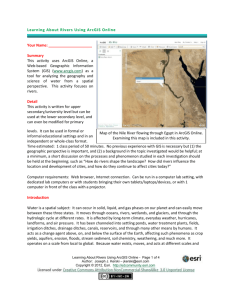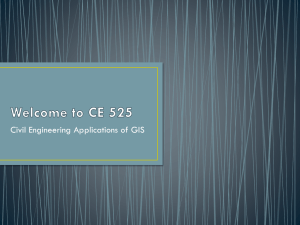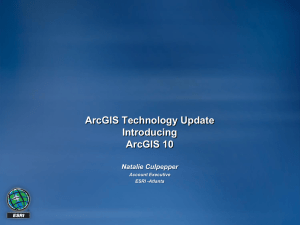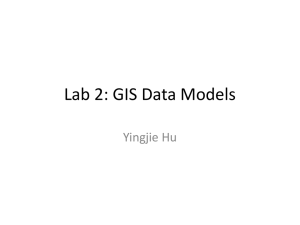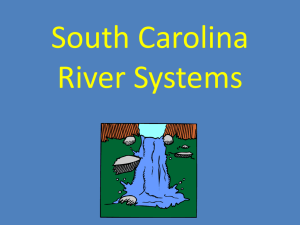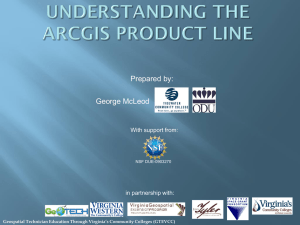sediment cities
advertisement
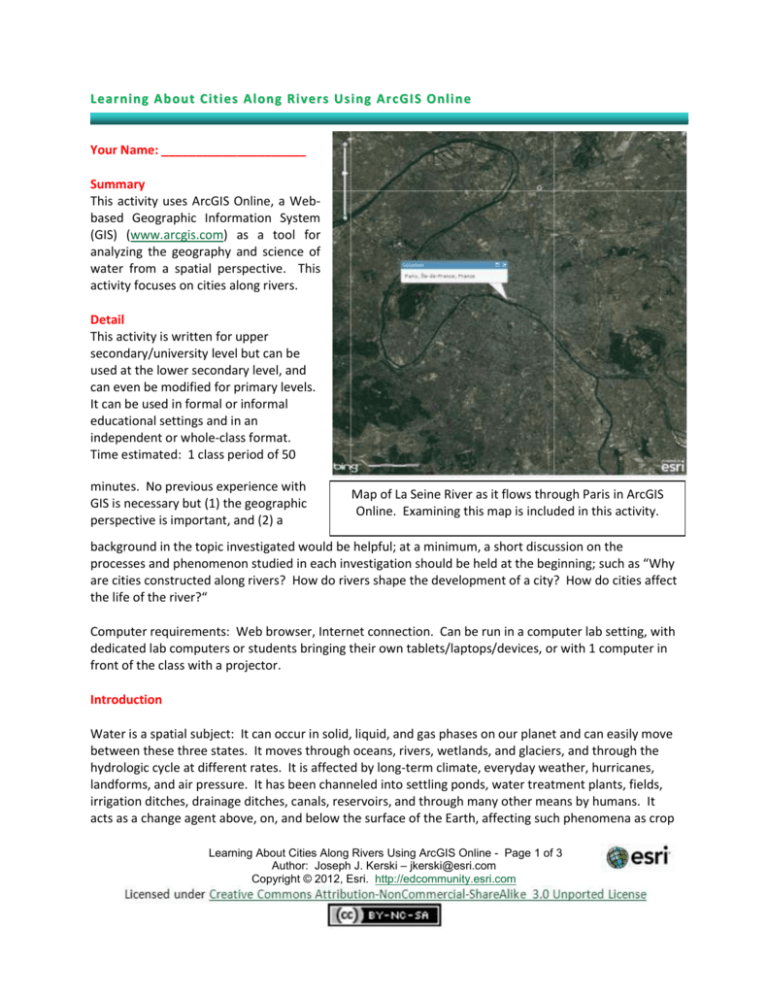
Learning About Cities Along Rivers Using ArcGIS Online Your Name: _____________________ Summary This activity uses ArcGIS Online, a Webbased Geographic Information System (GIS) (www.arcgis.com) as a tool for analyzing the geography and science of water from a spatial perspective. This activity focuses on cities along rivers. Detail This activity is written for upper secondary/university level but can be used at the lower secondary level, and can even be modified for primary levels. It can be used in formal or informal educational settings and in an independent or whole-class format. Time estimated: 1 class period of 50 minutes. No previous experience with GIS is necessary but (1) the geographic perspective is important, and (2) a Map of La Seine River as it flows through Paris in ArcGIS Online. Examining this map is included in this activity. background in the topic investigated would be helpful; at a minimum, a short discussion on the processes and phenomenon studied in each investigation should be held at the beginning; such as “Why are cities constructed along rivers? How do rivers shape the development of a city? How do cities affect the life of the river?“ Computer requirements: Web browser, Internet connection. Can be run in a computer lab setting, with dedicated lab computers or students bringing their own tablets/laptops/devices, or with 1 computer in front of the class with a projector. Introduction Water is a spatial subject: It can occur in solid, liquid, and gas phases on our planet and can easily move between these three states. It moves through oceans, rivers, wetlands, and glaciers, and through the hydrologic cycle at different rates. It is affected by long-term climate, everyday weather, hurricanes, landforms, and air pressure. It has been channeled into settling ponds, water treatment plants, fields, irrigation ditches, drainage ditches, canals, reservoirs, and through many other means by humans. It acts as a change agent above, on, and below the surface of the Earth, affecting such phenomena as crop Learning About Cities Along Rivers Using ArcGIS Online - Page 1 of 3 Author: Joseph J. Kerski – jkerski@esri.com Copyright © 2012, Esri. http://edcommunity.esri.com yields, aquifers, erosion, floods, stream sediment, soil chemistry, weathering, and much more. It operates on a scale from local to global. Because water exists, moves, and acts at different scales and affects so many other phenomena, the geographic perspective is critical to understanding it. And, GIS is a very useful tool in which to study water in all of its forms, processes, and aspects. Watch the movie “geographic reflections on water”: http://youtu.be/ntJvY4LixqQ Name 3 connections between water and geography. Because of these and a whole host of other factors, the geographic perspective is critical to understanding water. GIS allows the geographic perspective to be applied to the study of water, and ArcGIS Online provides a toolkit and rich set of data that allows you to study water right away. ArcGIS Online Investigation This investigation uses ArcGIS Online, on http://www.arcgis.com. Investigating Cities Along Rivers At ArcGIS Online (www.arcgis.com) click on “map.” Change the basemap to Topographic. Find the following rivers: The Amazon, the Nile, the Yangtze, and the Volga. Identify at least 3 major cities along each river. Change the basemap to imagery and examine urbanization along each river. Using “Add content”, find and add a map of country population. Based on your analysis of cities, settlement patterns, and population, answer the following questions: Which river has the most people living adjacent to it (i.e. within approximately 20 kilometers)? How does population pressure influence water quality along each river? Zoom into the following cities: Manaus, on the Amazon, Cairo, on the Nile, Shanghai, on the Yangtze, and Balakovo, on the Volga. On what continents and in what countries are these cities located? Change the basemap to imagery. How did the river influence the original location of each city? How has each city evolved over time? How does the river affect current day land use patterns? Which city’s river contains the most sediment, according to the satellite imagery? How is visual sediment a good indicator of water quality? How is visual sediment limited in terms of what it can tell us about water quality? Learning About Cities Along Rivers Using ArcGIS Online - Page 2 of 3 Author: Joseph J. Kerski – jkerski@esri.com Copyright © 2012, Esri. http://edcommunity.esri.com Zoom in to different points along each river in each city and change the basemap to imagery. What percentage of the river’s banks in each city would you say are walkable? What percentage of the river’s banks are devoted to parks, versus residential, industrial, and commercial development? What do your answers tell you about how each city views its river as a resource? Examine how the Seine River flows through Paris and describe how it does so. How does the course of a river moving through a city influence the city’s connection with the river? How do you think the Seine influenced how Paris grew and developed? Zoom in to different points along the Seine in Paris and change the basemap to imagery. What percentage of the river’s banks in Paris would you say are walkable? What percentage of the river’s banks are devoted to parks, versus residential, industrial, and commercial development? Use ArcGIS Online to examine topographic and image maps of your own community. What rivers and streams are important to your community? Did rivers affect why your community was originally founded? Did rivers affect how your community grew and developed? Does your community take steps to protect the riverbanks as parks or open space? What other land use is along the rivers in your community? Synthesis Name three things you have learned about cities along rivers through any of the above investigations. Name three things you have learned about GIS through these investigations. How has the spatial perspective about cities along rivers influenced your understanding of them? If time permits, use the presentation mode in ArcGIS Explorer Online to create a presentation of your own choosing where you explain what you have learned about a specific aspect about cities along rivers. Give your presentation to your peers, save it, and share it with others. Additional Explorations You have explored a few aspects of cities along rivers from a spatial perspective, but much more could be done. Write your own question about cities along rivers, investigate it, and answer it! Learning About Cities Along Rivers Using ArcGIS Online - Page 3 of 3 Author: Joseph J. Kerski – jkerski@esri.com Copyright © 2012, Esri. http://edcommunity.esri.com

